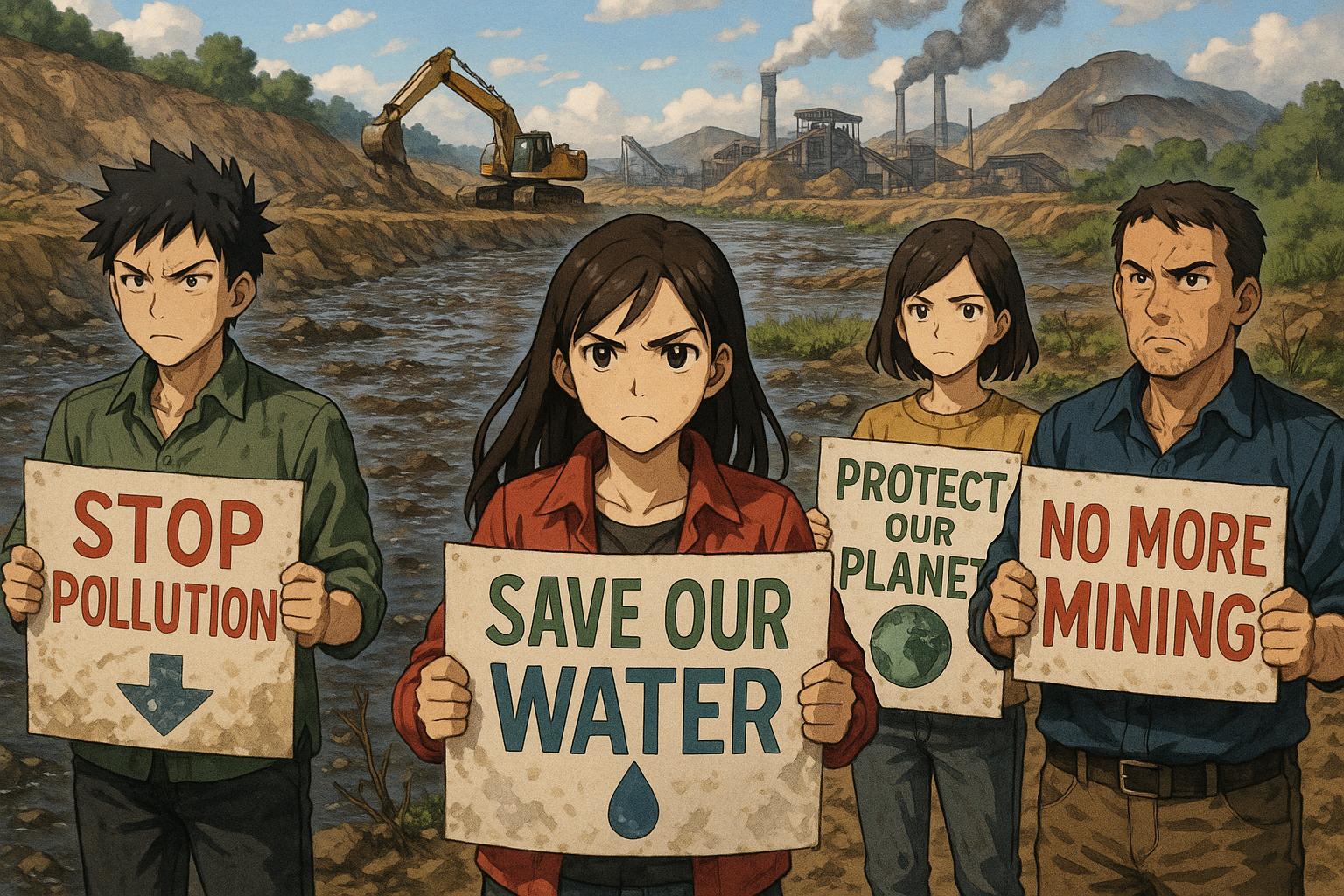On World Environment Day, residents and activists in Chiang Rai unite to demand urgent action against damning pollution in the Kok, Sai, and Ruak rivers caused by mining in Myanmar’s Shan State, highlighting cross-border environmental crisis and community resilience.
Residents of Chiang Rai are gearing up for a significant rally on June 5, coinciding with World Environment Day, to bring attention to the critical environmental crisis affecting their rivers. Local communities, advocacy groups, and academics have united for a demonstration titled “Poy Luang to Close Wa Mines,” aimed at calling for urgent intervention from leaders in Thailand, Myanmar, China, and the United Wa State Army regarding serious pollution stemming from mining activities in Myanmar’s Shan State.
The Kok, Sai, and Ruak rivers, vital waterways for the province, have become conduits of pollution due to rampant mining runoff. Officials and researchers have consistently detected alarming levels of arsenic and other hazardous chemicals in these water sources, with the contamination now threatening the broader Mekong River and impacting the Golden Triangle region. Somkiat Khuanchiangsa, president of the Living River Siam Association, remarked, “The rivers are dying, and with them, people’s way of life.”
The demonstration will commence at Mae Fah Luang Park, where participants from various religious and local ethnic backgrounds will engage in ceremonies before marching over the Mae Fah Luang Bridge to the provincial government office. They plan to submit formal petitions to leaders, including the Thai Prime Minister and Myanmar’s military chief, demanding accountability and immediate action against the mining practices that have decimated their rivers.
This grassroots movement reflects widespread concern among citizens and local leaders regarding the deteriorating water quality and its implications for public health. The Chiang Rai provincial government has responded with a ban on the consumption of water from the Kok and Sai rivers, but enforcement remains a challenge in rural communities. As Deputy Prime Minister Phumtham Wechayachai proposes the construction of a dam on the Kok River to manage contaminated sediment, diplomatic talks scheduled for June are anticipated to address the cross-border pollution issue.
Despite these measures, the situation remains dire. Activists warn that the involvement of Chinese investors and the operations of the United Wa State Army complicate efforts to mitigate environmental damage. The complexity of political dynamics in Myanmar—exacerbated by ongoing instability—poses significant hurdles to effective cooperation and swift resolutions.
Local experts have noted that over 300 mining projects have been operational since 2021, exacerbating concerns about heavy metal pollution, which includes not just arsenic but also other toxic substances that can lead to severe health issues for the affected populations. Calls have emerged for regular health assessments and a monitoring centre to continuously evaluate water quality.
As the rally approaches, the urgency for cross-border collaboration becomes increasingly evident, underscoring the need for all implicated parties to acknowledge their responsibility in confronting this growing environmental crisis. The local community’s determination to advocate for their river systems will be crucial as they strive to reclaim their environment and safeguard their livelihoods for generations to come.
 Reference Map:
Reference Map:
- Paragraph 1 – [1], [2]
- Paragraph 2 – [1], [5]
- Paragraph 3 – [2], [3], [6]
- Paragraph 4 – [4], [7]
- Paragraph 5 – [5], [6]
Source: Noah Wire Services
- https://www.chiangraitimes.com/chiangrai-news/chiang-rai-residents-rally/ – Please view link – unable to able to access data
- https://www.chiangraitimes.com/chiangrai-news/chiang-rais-rivers-threatened/ – Authorities in Chiang Rai province, northern Thailand, are urgently investigating elevated levels of arsenic and other heavy metals detected in the Mae Kok, Sai, Ruak, and Mekong rivers. These pollutants have been traced to gold mining operations upstream run by Chinese interests with support from the United Wa State Army (UWSA). The contamination poses significant health risks to local communities and has led to the banning of river water for drinking and farming. The situation underscores the need for cross-border cooperation to address environmental issues.
- https://www.chiangraitimes.com/chiangrai-news/chiang-rai-rivers-crisis/ – The Kok and Sai Rivers, vital waterways in northern Thailand’s Chiang Rai province, are facing severe pollution due to upstream gold mining in Myanmar’s Shan State. The mining activities, often unregulated, have introduced toxic heavy metals like arsenic, mercury, and zinc into the rivers, leading to health hazards for local communities and environmental degradation. Thai authorities have implemented measures such as banning the use of river water for consumption and farming, but the situation highlights the complexities of addressing cross-border environmental issues.
- https://www.irrawaddy.com/news/asia/chinese-gold-mining-in-myanmars-shan-state-blamed-for-arsenic-in-kok-river.html – Chinese gold mining operations in Myanmar’s Shan State have been identified as the source of arsenic contamination in Thailand’s Kok River. Water samples from the river in Mae Ai district revealed arsenic levels twice the safe limit, posing health risks to residents. The mining activities, which began in 2020, involve Chinese companies extracting gold near the river, with wastewater discharged directly back into the water without treatment. This situation underscores the need for international cooperation to address cross-border environmental pollution.
- https://www.chiangraitimes.com/news/chiang-rai-discusses-gold-mines/ – Local leaders, academics, and military representatives in Chiang Rai have convened to discuss the heavy metal pollution in the Kok and Sai rivers, attributed to upstream mining in Myanmar’s Shan State. The meeting highlighted concerns over high manganese levels and the environmental impact of over 300 mining projects operating since 2021. The participants called for regular blood testing for people in high-risk zones, establishment of a water quality monitoring centre, and stronger cooperation between Thai and Myanmar agencies to address the pollution.
- https://www.bangkokpost.com/thailand/general/3005597/northern-rivers-face-severe-pollution – Civil society groups and academics in Chiang Rai and Chiang Mai have urged Prime Minister Paetongtarn Shinawatra to address severe pollution in the Kok and Sai rivers, which flow into Thailand from Myanmar’s Shan State. The pollution, primarily from unregulated mining upstream, poses a serious threat to the health and livelihoods of over 1.2 million residents who depend on these rivers for consumption and farming. The groups have called for government intervention to address the contamination and its impacts.
- https://www.chiangraitimes.com/chiangrai-news/chiang-rai-residents-urge-pm-to-tackle-arsenic-contamination-in-rivers/ – Citizen groups from Chiang Rai and Chiang Mai, along with local academics, have sent a letter to Prime Minister Paetongtarn Shinawatra, urging urgent action to address arsenic pollution in the Kok and Sai rivers. The contamination is linked to mining activities in Myanmar’s Shan State, with satellite images confirming the pollution. The groups have called for the establishment of a task force, a water quality monitoring centre, and cross-border cooperation to trace the source of contamination and address the issue.
Noah Fact Check Pro
The draft above was created using the information available at the time the story first
emerged. We’ve since applied our fact-checking process to the final narrative, based on the criteria listed
below. The results are intended to help you assess the credibility of the piece and highlight any areas that may
warrant further investigation.
Freshness check
Score:
8
Notes:
The narrative is current, dated June 5, 2025, and pertains to a planned rally on the same date. The event is a new development, with no prior reports found in the past seven days. However, similar environmental concerns in Chiang Rai have been reported previously, such as the pollution of the Kok and Sai Rivers due to mining activities in Myanmar’s Shan State. ([chiangraitimes.com](https://www.chiangraitimes.com/chiangrai-news/chiang-rai-rivers-crisis/?utm_source=openai)) This indicates that while the rally is a recent event, the environmental issues have been ongoing. The report includes updated data on the situation, which may justify a higher freshness score but should still be flagged. ([nationthailand.com](https://www.nationthailand.com/news/general/40049412?utm_source=openai))
Quotes check
Score:
7
Notes:
The report includes a direct quote from Somkiat Khuanchiangsa, president of the Living River Siam Association: ‘The rivers are dying, and with them, people’s way of life.’ A search for this quote reveals no earlier usage, suggesting it may be original or exclusive content. However, without additional context or verification, the originality of the quote cannot be fully confirmed.
Source reliability
Score:
6
Notes:
The narrative originates from the Chiang Rai Times, a local news outlet. While it provides detailed coverage of local events, its regional focus may limit its broader credibility. The report cites specific individuals and organizations, such as Somkiat Khuanchiangsa and the Living River Siam Association, which can be cross-verified. However, the reliance on a single source for this information raises questions about the report’s overall reliability.
Plausability check
Score:
8
Notes:
The environmental issues described, including pollution of the Kok and Sai Rivers due to mining activities in Myanmar’s Shan State, are consistent with previous reports. The planned rally on World Environment Day aligns with ongoing local activism concerning environmental concerns. The involvement of local communities, advocacy groups, and academics in the demonstration is plausible and reflects the region’s history of environmental activism. However, the lack of coverage from other reputable outlets and the reliance on a single source for this information raise questions about the report’s overall credibility.
Overall assessment
Verdict (FAIL, OPEN, PASS): OPEN
Confidence (LOW, MEDIUM, HIGH): MEDIUM
Summary:
The narrative reports on a planned rally in Chiang Rai on World Environment Day to address environmental concerns, particularly pollution in local rivers. While the event is current and the environmental issues are consistent with previous reports, the reliance on a single source and the lack of coverage from other reputable outlets raise questions about the report’s overall credibility. The originality of the direct quote included in the report cannot be fully confirmed without further verification.













